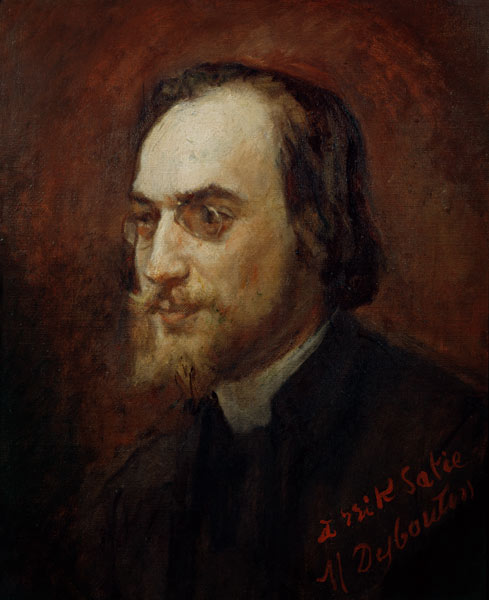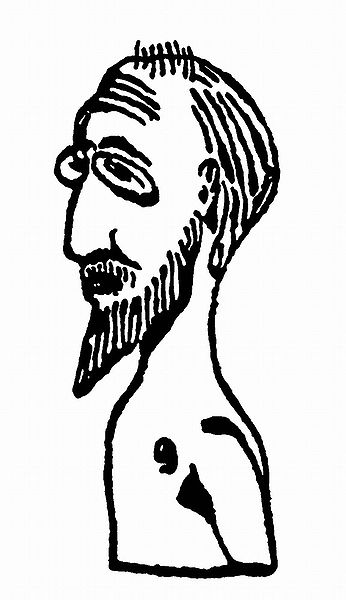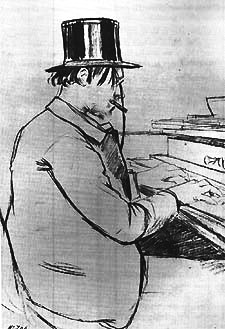<Back to Index>
- Composer and Pianist Éric Alfred Leslie Satie (Erik Satie), 1866
PAGE SPONSOR
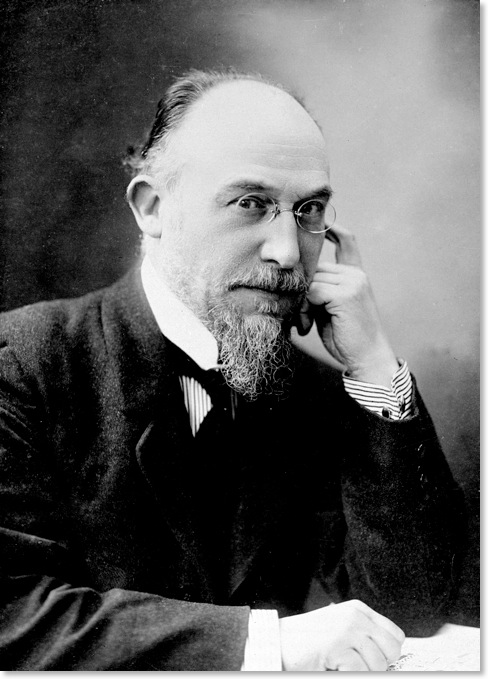
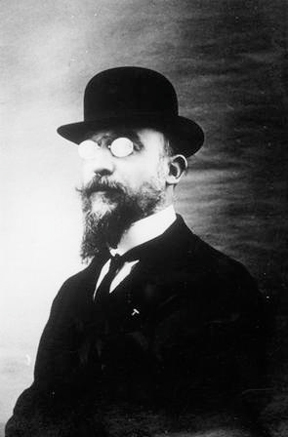
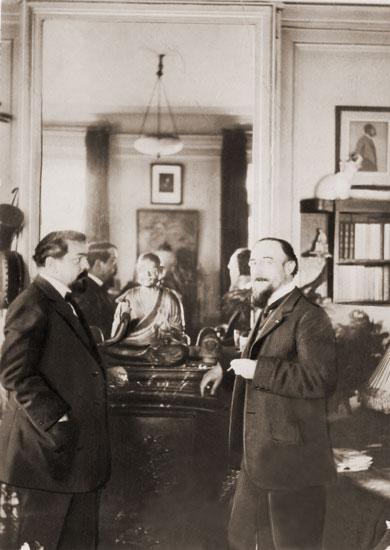
Éric Alfred Leslie Satie (17 May 1866 – Paris, 1 July 1925; signed his name Erik Satie after 1884) was a French composer and pianist. Satie was a colorful figure in the early 20th century Parisian avant garde. His work was a precursor to later artistic movements such as minimalism, repetitive music, and the Theater of the Absurd.
An eccentric, Satie was introduced as a "gymnopedist" in 1887, shortly before writing his most famous compositions, the Gymnopédies. Later, he also referred to himself as a "phonometrician" (meaning "someone who measures sounds") preferring this designation to that of a "musician", after having been called "a clumsy but subtle technician" in a book on contemporary French composers published in 1911.
In addition to his body of music, Satie also left a remarkable set of
writings, having contributed work for a range of publications, from the
dadaist 391 to the American culture chronicle Vanity Fair.
Although in later life he prided himself on always publishing his work
under his own name, in the late nineteenth century he appears to have
used pseudonyms such as Virginie Lebeau and François de Paule in some of his published writings.
Satie was the son of Alfred Satie and his wife Jane Leslie (née Anton), who was born in London to Scottish parents. Erik was born at Honfleur in Normandy; his home there is open to the public. When Satie was four years old, his family moved to Paris, his father having been offered a translator's job in the capital. After his mother's death in 1872, he was sent, together with his younger brother, Conrad, back to Honfleur, to live with his paternal grandparents. There, he received his first music lessons from a local organist. When his grandmother died in 1878, the two brothers were reunited with their father in Paris, who remarried (a piano teacher) shortly afterwards. From the early 1880s onwards, Satie started publishing salon compositions by his step mother and himself, among others.
In 1879, Satie entered the Paris Conservatoire,
where he was soon labelled untalented by his teachers. Georges Mathias,
his professor of piano at the Conservatoire, described his pupil's
piano technique in flatly negative terms, "insignificant and laborious"
and "worthless". Émile Descombes called him "the laziest student in the
Conservatoire".
Years later, Satie related that Mathias, with great insistence, told
him that his real talent lay in composing. After being sent home for
two - and - a - half years, he was readmitted to the Conservatoire at
the end
of 1885, but was unable to make a much more favorable impression on his
teachers than he had before, and, as a result, resolved to take up
military service
a year later. However, Satie's military career did not last very long;
within a few months he was discharged after deliberately infecting
himself with bronchitis.
In 1887, Satie left home to take lodgings in Montmartre. By this time, he had started what was to be an enduring friendship with the romantic poet Patrice Contamine, and had had his first compositions published by his father. He soon integrated with the artistic clientele of the Le Chat Noir Café - cabaret, and started publishing his Gymnopédies. Publication of compositions in the same vein (Ogives, Gnossiennes, etc.) followed. In the same period he befriended Claude Debussy. He moved to a smaller room, still in Montmartre (rue Cortot N° 6), in 1890. By 1891 he was the official composer and chapel master of the Rosicrucian Order "Ordre de la Rose - Croix Catholique, du Temple et du Graal", led by Sâr Joséphin Péladan, which led to compositions such as Salut drapeau!, Le fils des étoiles, and the Sonneries de la Rose + Croix. Satie gave performances at the Salon de la Rose + Croix, organized by Péladan.
By mid 1892, he had composed the first pieces in a compositional system of his own making (Fête donnée par des Chevaliers Normands en l'honneur d'une jeune demoiselle), had provided incidental music to a chivalric esoteric play (two Prélude du Nazaréen), had had his first hoax published (announcing the premiere of Le bâtard de Tristan, an anti - Wagnerian opera he probably never composed), and had broken with Péladan, starting that autumn with the Uspud project, a "Christian Ballet", in collaboration with Contamine de Latour. While the comrades from both the Chat Noir and Miguel Utrillo's Auberge du Clou sympathized, a promotional brochure was produced for the project, which reads as a pamphlet for a new esoteric sect.
In 1893, he met the young Maurice Ravel
for the first time, Satie's style emerging in the first compositions of
the youngster. One of Satie's own compositions of that period, the Vexations, was to remain undisclosed until after his death. By the end of the year he had founded the Eglise Métropolitaine d'Art de Jésus Conducteur
(the Metropolitan Church of Art of the Leading Christ). As its only
member, in the role of "Parcier et Maître de Chapelle" he started to
compose a Grande messe (later to become known as the Messe des pauvres),
and wrote a flood of letters, articles and pamphlets showing off his
self - assuredness in religious and artistic matters. To give an example:
he applied for membership of the Académie Française
twice, leaving no doubt in the application letter that the board of
that organization (presided by Camille Saint - Saëns) as much as owed
him such membership. Such proceedings without doubt rather helped to
wreck his popularity in the cultural establishment. In 1895 he inherited
some money, allowing him to have more of his
writings printed, and to change from wearing a priest - like habit to
being the "Velvet Gentleman".
By mid 1896 all of Satie's financial means had vanished, and he had to move to cheaper and much smaller lodgings, first at the Rue Cortot, and two years later, after he'd composed the two first sets of Template: Pièces froides in 1897, to Arcueil, a suburb some five kilometers from the center of Paris. During this period he re-established contact with his brother Conrad for numerous practical and financial matters, disclosing some of his inner feelings in the process. The letters to Conrad made it clear that he had set aside any religious ideas.
From 1899 on Satie started making money as a cabaret pianist, adapting over a hundred compositions of popular music for piano or piano and voice, adding some of his own. The most popular of these were Je te veux, text by Henry Pacory; Tendrement, text by Vincent Hyspa; Poudre d'or, a waltz; La diva de l'"Empire", text by Dominique Bonnaud / Numa Blès; Le Picadilly, a march; Légende californienne, text by Contamine de Latour lost, but the music later reappears in La belle excentrique; and many more, many of which have been lost. In his later years Satie would reject all his cabaret music as vile and against his nature, but for the time being, it was an income.
Only a few compositions that Satie took seriously remain from this period: Jack in the Box, music to a pantomime by Jules Depaquit (called a "clownerie" by Satie), Geneviève de Brabant, a short comic opera on a serious theme, text by Lord Cheminot, The Dreamy Fish, piano music to accompany a lost tale by Lord Cheminot, and a few others that were mostly incomplete, hardly any of them staged, and none of them published at the time.
Both Geneviève de Brabant and The Dreamy Fish have been analyzed by Ornella Volta as containing elements of competition with Claude Debussy, of which Debussy was probably not aware, Satie not making this music public. Meanwhile, Debussy was having one of his first major successes with Pelléas et Mélisande in 1902, leading a few years later to ‘who - was - precursor - to - whom’ debates between the two composers, in which Maurice Ravel would also get involved.
In October 1905 Satie enrolled in Vincent d'Indy's Schola Cantorum de Paris to study classical counterpoint while still continuing his cabaret work. Most of his friends were as dumbfounded as the professors at the Schola when they heard about his new plan to return to the classrooms, especially as d'Indy was an admiring pupil of Saint - Saëns, not particularly favored by Satie. Satie would follow these courses at the Schola, as a respected pupil, for more than five years, receiving a first (intermediate) diploma in 1908. Some of his classroom counterpoint exercises, such as the Désespoir agréable, were published after his death. Another summary, of the period prior to the Schola, also appeared in 1911: the Trois morceaux en forme de poire, which was a kind of compilation of the best of what he had written up to 1903.
Something that becomes clear through these published compilations is that Satie did not so much reject Romanticism and its exponents like Wagner, but that he rejected certain aspects of it. From his first composition to his last, he rejected the idea of musical development, in the strict definition of this term: the intertwining of different themes in a development section of a sonata form. As a result, his contrapuntal and other works were very short; the "new, modern" Fugues do not extend further than the exposition of the theme(s). Generally, he would say that he did not think it permitted that a composer take more time from his public than strictly necessary. Also Melodrama, in its historical meaning of the then popular romantic genre of "spoken words to a background of music", was something Satie avoided. His 1913 Le piège de Méduse could be seen as an absurdistic spoof of that genre.
In the meantime, other changes had also taken place: Satie had become
a member of a radical socialist party, and had socialized with the
Arcueil community: Amongst other things, he'd been involved in the "Patronage laïque"
work for children. He also changed his appearance to that of the
'bourgeois functionary' with bowler hat, umbrella, etc. He channeled
his medieval interests into a peculiar secret hobby:
In a filing cabinet he maintained a collection of imaginary buildings,
most of them described as being made out of some kind of metal, which he
drew on little cards. Occasionally, extending the game, he would
publish anonymous small announcements in local journals, offering some
of these buildings, e.g., a "castle in lead", for sale or rent.
Starting in 1912, Satie's new humorous miniatures for piano became very successful, and he wrote and published many of these over the next few years (most of them premiered by the pianist Ricardo Viñes). His habit of accompanying the scores of his compositions with all kinds of written remarks was now well established so that a few years later he had to insist that these not be read out during performances. He had mostly stopped using barlines by this time. In some ways these compositions were very reminiscent of Rossini's compositions from the final years of his life, grouped under the name Péchés de vieillesse.
However the acceleration in Satie's life did not come so much from the success of his new piano pieces; it was Ravel who inadvertently triggered the characteristics of Satie's remaining years and thus influenced the successive progressive artistic and cultural movements that rapidly manifested themselves in Paris over the following years. Paris was seen as the artistic capital of the world, and the beginning of the new century appeared to have set many minds on fire. In 1910 the "Jeunes Ravêlites", a group of young musicians around Ravel, proclaimed their preference for Satie's earlier work from before the Schola period, reinforcing the idea that Satie had been a precursor of Debussy.
At first Satie was pleased that at least some of his works were receiving public attention, but when he realized that this meant that his more recent work was overlooked or dismissed, he looked for other young artists who related better to his more recent ideas, so as to have better mutual support in creative activity. Thus young artists such as Roland - Manuel, and later Georges Auric, and Jean Cocteau, started to receive more of his attention than the "Jeunes".
As a result of his contact with Roland - Manuel, Satie again began publicizing his thoughts, with far more irony than he had done before (amongst other things, the Mémoires d'un amnésique and Cahiers d'un mammifère).
With Jean Cocteau, whom he had first met in 1915, Satie started work on incidental music for a production of Shakespeare's A Midsummer Night's Dream (resulting in the Cinq grimaces). From 1916, he and Cocteau worked on the ballet Parade, which was premiered in 1917 by Sergei Diaghilev's Ballets Russes, with sets and costumes by Pablo Picasso, and choreography by Léonide Massine. Through Picasso, Satie also became acquainted with other cubists, such as Georges Braque, with whom he would work on other, aborted, projects.
With Georges Auric, Louis Durey, Arthur Honegger, and Germaine Tailleferre Satie formed the Nouveaux jeunes, shortly after writing Parade. Later the group was joined by Francis Poulenc and Darius Milhaud. In September 1918, Satie – giving little or no explanation – withdrew from the Nouveaux jeunes. Jean Cocteau gathered the six remaining members, forming the Groupe des six (to which Satie would later have access, but later again would fall out with most of its members).
From 1919 Satie was in contact with Tristan Tzara, the initiator of the Dada movement. He became acquainted with other artists involved in the movement, such as Francis Picabia (later to become a Surrealist), André Derain, Marcel Duchamp, Jean Hugo and Man Ray, among others. On the day of his first meeting with Man Ray, the two fabricated the artist's first readymade: The Gift (1921). Satie contributed writing to the Dadaist publication 391. In the first months of 1922 he was surprised to find himself entangled in the argument between Tzara and André Breton about the true nature of avant garde art, epitomised by the failure of the Congrès de Paris. Satie originally sides with Tzara, but manages to maintain friendly relations with most players in both camps. Meanwhile, an "Ecole d'Arcueil" had formed around Satie, with young musicians like Henri Sauguet, Maxime Jacob, Roger Désormière and Henri Cliquet - Pleyel.
Finally he composed an "instantaneist" ballet (Relâche) in collaboration with Picabia, for the Ballets Suédois of Rolf de Maré. In a simultaneous project, Satie added music to the surrealist film Entr'acte by René Clair, which was given as an intermezzo for Relâche.
Satie and Suzanne Valadon, an artists' model and artist in her own right, and a long time friend of Miguel Utrillo (and mother of Maurice Utrillo), began an affair early in 1893. After their first night together, he proposed marriage. The two did not marry, but Valadon moved to a room next to Satie's at the Rue Cortot. Satie became obsessed with her, calling her his Biqui, and writing impassioned notes about "her whole being, lovely eyes, gentle hands, and tiny feet". During their relationship, Satie composed the Danses gothiques as a kind of prayer to restore peace of mind, and Valadon painted a portrait of Satie, which she gave to him. After six months she moved away, leaving Satie broken hearted. Afterwards, he said that he was left with "nothing but an icy loneliness that fills the head with emptiness and the heart with sadness". It is believed this was the only intimate relationship Satie ever had.
After years of heavy drinking, Satie died on 1 July 1925 from cirrhosis of the liver.
He is buried in the cemetery in Arcueil. There is a tiny stone monument
designating a grassy area in front of an apartment building — 'Parc Erik
Satie'. Over the course of his 27 years in residence at Arcueil,
no one had ever visited his room. After his death, Satie's friends
discovered compositions that were totally unknown or thought to have
been lost. The orchestral score to Parade
was thought, by Satie, to have been left on a bus years before. These
were found behind the piano, in the pockets of his velvet suits, and in
other odd places, and included the Vexations; Geneviève de Brabant and other unpublished or unfinished stage works; The Dreamy Fish; many Schola Cantorum
exercises; a previously unseen set of "canine" piano pieces; and
several other works for piano, many untitled. Some of these would be
published later as additional Gnossiennes, Pièces froides, Enfantines, and furniture music.
